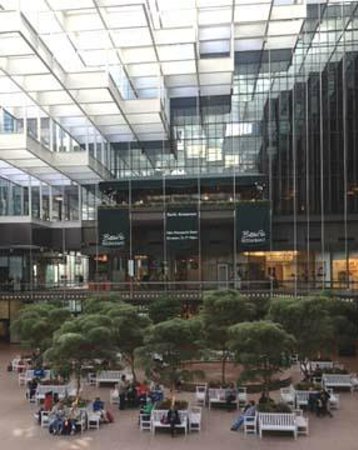MINNEAPOLIS ARCHITECTURE
CATEGORY: MRS. ANDERSON
PHOTOS: 1) IDS BUILDING CRYSTAL COURT
2) HENNIPIN COUNTY CENTER
 Having access to great gobs of prairie wheat and other produce, Minneapolis started right out cashing in. It ended up having the world’s largest flour mills and food preservation plants—think Pillsbury—think General Foods. From the beginning, that wealth purchased some of the nation’s best architecture. I saw many wonderful buildings while we were in Minneapolis including a Frank Lloyd Wright house, but the most amazing was the I D S complex in the heart of the city designed by Philip Johnson.
Having access to great gobs of prairie wheat and other produce, Minneapolis started right out cashing in. It ended up having the world’s largest flour mills and food preservation plants—think Pillsbury—think General Foods. From the beginning, that wealth purchased some of the nation’s best architecture. I saw many wonderful buildings while we were in Minneapolis including a Frank Lloyd Wright house, but the most amazing was the I D S complex in the heart of the city designed by Philip Johnson.
It consisted of four buildings: a 57 floor tower (called the IDS Building), an 8 story annex, a 19 story hotel and a 2 story department store. The outstanding feature however was a court yard that connected the four buildings called the Chrystal Court, surely paying homage to the 19th century Chrystal Palace in England. This courtyard was roofed by a glass-topped three-dimensional egg-crate space-frame that climbed from the two story department store height up to the eighth floor of the IDS tower. It was a masterpiece of engineering, spectacular in all its faceted complexity. We sat under this dramatic roof in a restaurant balcony on the fifth floor of the tower looking down into its first floor park-like space with full grown trees and magical fountains and filled with places for people to sit—at tables near food outlets and on benches. I thought that this was what architecture should be.
There were also sky walks, some of the first in the nation, that connected all the city center buildings so that people would not have to go out into the Minnesota winter cold or summer heat. We were told that the sky walks set up indoor air currents that actually created winds blowing from building to building.
Another building that I had seen in pictures and wanted to visit was the Hennepin County Government Building, built in 1973 and designed by John Carl Warnecke. When I first saw it in a photograph, I thought it was a truly handsome building. It consisted of two vertical, rectilinear towers standing side by side but with cantilevered projections at the top angling up and out to face each other, but not quite touching. Connecting these two forms was a wall of glass at both ends and over the top. The entrances were through the glass ends and the angle of the stairs going up to them mirrored the angle of the overhead cantilevers. Using this same angle, probably 45°, made the stairs too steep. When I walked into the building, the center glassed space seemed so over powering that I felt it was de-humanizing. The glass had diagonal metal bracing over its entire surface, adding to the prison like feel. I compared it to the IDS Building that, despite its amazing expanses of glass in the courtyard, had entrances that were in human scale and did not make people feel like ants waiting to be stepped on.

After visiting these two buildings I had an interesting discussion with some of Bob’s cousins about them. They told me that the whole block in front of the Hennepin Building was a county park that formed a fore court for the building. They said that Warnecke designed the court as well as the building. He specified extremely expensive tile pavers for its paved surface, which was most of the block. The tiles had to be shipped from Italy. It turned out that the tiles were so slick when wet that several people fell and were injured, and after the first big rain storm, the law suits started coming in. The county had to cordon the block until they could replace the tiles, this time with skid proof pavers.
As for the IDS Building, the cousins thought it was too tall for the city and stuck up “like a sore thumb.” I said I thought it was OK for a prairie city to have some height because everything else was so flat. I told them about the BIG COW and all the other BIG animals we had seen across the Great Plains. I said I thought that people who lived in such flat landscapes had a hunger for height. One of the cousins said, “Are you comparing the IDS building to a 50 ft. COW? Now you’ve got it right!”
When we look at pictures of Minneapolis today, there are many buildings taller than the IDS building, which is no longer the IDS building , but has a different name. It was the first and, in my opinion, the best. I wonder what Bob’s cousins think now. They could only hope that the high rises that followed were as good as that first “sore thumb.”
